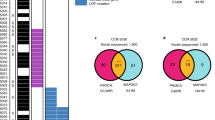Abstract
Cavernous malformations (CM) have long been considered congenital of central nervous system, while the mechanism of CMs detailed development process associated with genetic factors remains unclear. We reported an uncommon case which suffered spinal cord cavernous malformations. In this work, representative samples were obtained, and the sequenced results were described for the first time. A 9-year-old boy was found oblique shoulder with slightly weakness of left limbs; MRI indicated spinal cord cavernous malformations (CMs) located at the C4-C6 vertebral level. On genetic analysis, a shared mutation of PIK3CA (p.H1047R) in CMs and associated developmental venous anomalies (DVAs) was detected, with a different abundance (2% and 7%, respectively), and a somatic mutation of MAP3K3 (p.I441M) was detected in the CM tissue samples. This case provides better knowledge of the formation history and genetic triggers of the DVA-associated CMs. This evidence allows us to speculate the developmental history of the CM lesion: The DVA with PIK3CA mutation might be genetic precursor, and then the associated CM could be derived from terminal cell population of the DVA by acquiring a somatic mutation in MAP3K3.


Similar content being viewed by others
Availability of data and material
The data that support the findings of this study are available from the corresponding author Hongqi Zhang, upon reasonable request.
References
Hong T, Xiao X, Ren J et al (2021) Somatic MAP3K3 and PIK3CA mutations in sporadic cerebral and spinal cord cavernous malformations. Brain 144(9):2648–2658. https://doi.org/10.1093/brain/awab117
Snellings DA, Hong CC, Ren AA et al (2021) Cerebral cavernous malformation: from mechanism to therapy. Circ Res 129(1):195–215. https://doi.org/10.1161/CIRCRESAHA.121.318174
Labauge P, Denier C, Bergametti F, Tournier-Lasserve E (2007) Genetics of cavernous angiomas. Lancet Neurol 6(3):237–244. https://doi.org/10.1016/S1474-4422(07)70053-4
Fischer A, Zalvide J, Faurobert E, Albiges-Rizo C, Tournier-Lasserve E (2013) Cerebral cavernous malformations: from CCM genes to endothelial cell homeostasis. Trends Mol Med 19(5):302–308. https://doi.org/10.1016/j.molmed.2013.02.004
Peyre M, Miyagishima D, Bielle F et al (2021) Somatic PIK3CA mutations in sporadic cerebral cavernous malformations. N Engl J Med 385(11):996–1004. https://doi.org/10.1056/NEJMoa2100440
Snellings DA, Girard R, Lightle R et al (2022) Developmental venous anomalies are a genetic primer for cerebral cavernous malformations. Nat Cardiovasc Res 1:246–252. https://doi.org/10.1038/s44161-022-00035-7
Acknowledgements
We thank the patient for granting permission to publish this information. Thanks to Tianqi Tu M.D made a contribution in the study process.
Funding
This study is supported by the National Natural Science Foundation of China (Award Numbers: 82201440 and 81971113).
Author information
Authors and Affiliations
Contributions
Jian Ren collected the data and wrote the manuscript. Tao Hong and Hongqi Zhang designed this idea and checked the manuscript.
Corresponding author
Ethics declarations
Ethics approval and consent to participate
The manuscript is an original work and has not been submitted or is under consideration for publication in another journal. This study was approved by the Institutional Ethics Committee. We also confirm that all the listed authors have participated actively in the study and have seen and approved the submitted manuscript.
Consent for publication
The patient had given his consent for this information about himself to appear in the journal and associated publications.
Conflict of interest
The authors have no personal financial or institutional competing interest.
Additional information
Publisher's Note
Springer Nature remains neutral with regard to jurisdictional claims in published maps and institutional affiliations.
Rights and permissions
Springer Nature or its licensor (e.g. a society or other partner) holds exclusive rights to this article under a publishing agreement with the author(s) or other rightsholder(s); author self-archiving of the accepted manuscript version of this article is solely governed by the terms of such publishing agreement and applicable law.
About this article
Cite this article
Ren, J., Hong, T. & Zhang, H. Angioarchitecture and genetic variants of spinal cord cavernous malformations and associated developmental venous anomalies: a case report. Childs Nerv Syst 39, 1945–1948 (2023). https://doi.org/10.1007/s00381-023-05887-3
Received:
Accepted:
Published:
Issue Date:
DOI: https://doi.org/10.1007/s00381-023-05887-3




